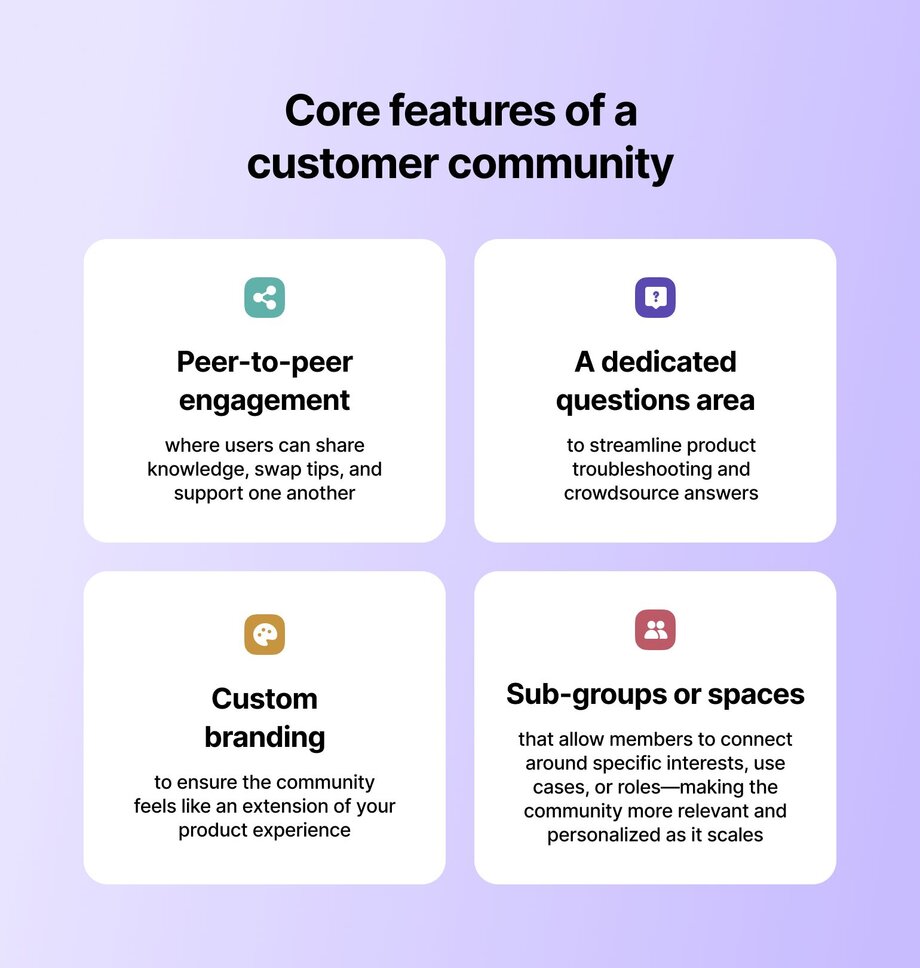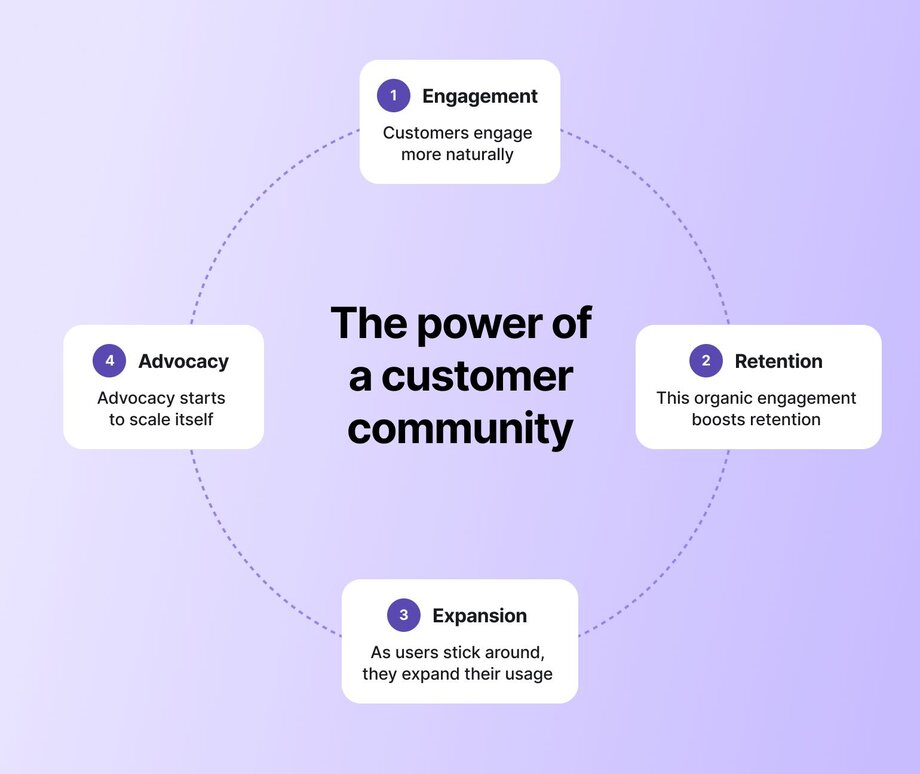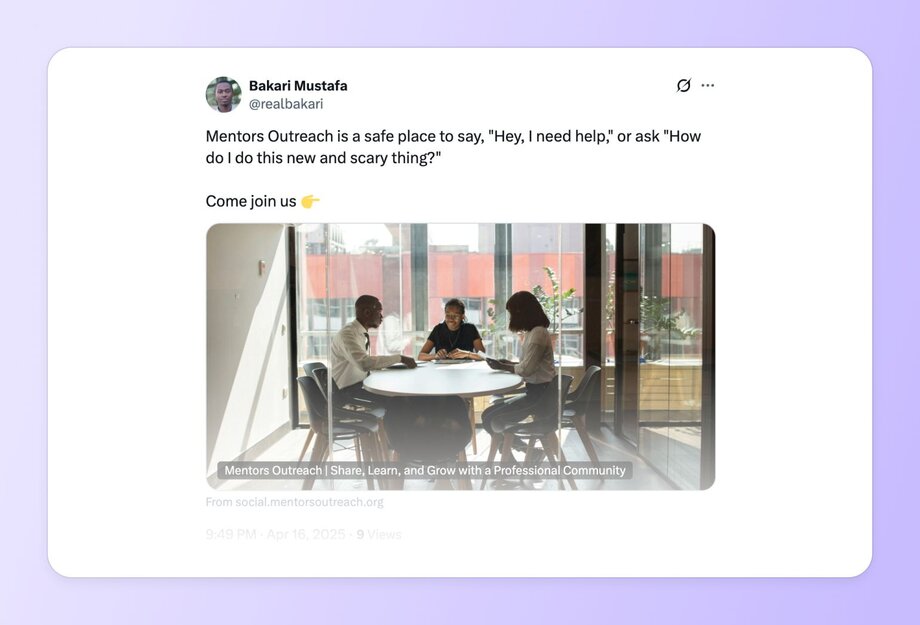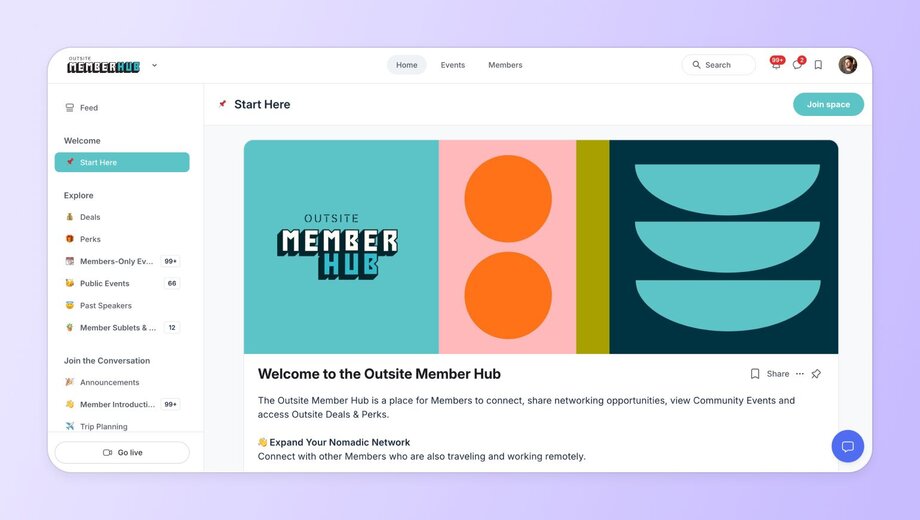How customer communities improve retention—and lower churn
Customer communities are the secret weapon behind some of the most successful businesses. They cultivate passionate, engaged communities where users can learn and share.
The result? Faster onboarding, stickier users, and more organic growth through word-of-mouth.
The impact is measurable. For instance:
- Engaged community members are 3x less likely to churn.
- Adobe found that customers who engage with its community are 4x more likely to renew their subscriptions than those who do not.
- Salesforce's Trailblazer community answers 83% of user questions through peer support, saving around $2 million monthly.
- HeyOrca (a social media management platform) cut acquisition costs 80% by building community first
And this is just the tip of the iceberg. In this article, we’ll explore:
- What a customer community is, and what kind of value they provide
- The four most common types of customer communities
- Real-world examples of successful communities
- A step-by-step guide to building your own community
What is a customer community?
A customer community is a space where customers can connect, share insights, troubleshoot, and engage directly with your brand.
Often, customer communities are associated with larger brands, but they work just as effectively for businesses of all sizes. Whether you're a startup or an established company, creating a dedicated space for your customers:
- fosters stronger relationships,
- speeds up problem-solving, and
- drives more meaningful engagement.
Unlike a traditional forum, support center, or glorified FAQ section, a successful community fosters deeper loyalty in your brand. It’s more than just a place to ask questions—it’s a space where users can exchange experiences, offer solutions, and explore new ways to get the most out of your product.

A customer community often includes one or all of the following core features:
- Peer-to-peer engagement, where users can share knowledge, swap tips, and support one another
- A dedicated questions area to streamline product troubleshooting and crowdsource answers
- Custom branding to ensure the community feels like an extension of your product experience
- Sub-groups or spaces that allow members to connect around specific interests, use cases, or roles—making the community more relevant and personalized as it scales.
What’s the benefit of a customer community?
When customers hit a roadblock—whether it’s confusion over a new feature or frustration with limited support—they often disengage quietly. Without a clear path forward, even the most promising users can lose momentum and drift away.
But with a thriving community, they’re surrounded by inspiration, shared wins (or camaraderie in the frustrations), and a sense of progress that keeps them moving. For companies, these spaces reduce the burden on support teams, improve retention by keeping users active and invested, and reveal valuable product insights that shape smarter decisions.
Here’s why and how a customer community supports your users:
- Ongoing support when they need it most: A customer community offers continued support well beyond onboarding. Whether users are troubleshooting an issue or diving into advanced features, they can get answers quickly, often from peers who’ve been there, without waiting in a customer service queue.
- Builds connection: Communities go beyond transactions; they foster interaction. Users can join discussions, attend live events, and share their own insights. This sense of connection builds loyalty and keeps them coming back.
- Faster learning and discoveries: Users can explore new use cases, uncover lesser-known features, and learn from real-world examples. Seeing how others creatively use the product helps them unlock more value and deepen their expertise.
- Motivation through shared goals: Whether mastering a new feature or reaching a usage milestone, being part of a community keeps users inspired. Seeing others succeed boosts motivation and helps them stay committed to their goals.
Why customer communities are your secret growth engine
A strong customer community delivers measurable value across the customer lifecycle, not just at onboarding. Think of it not as a funnel but as a flywheel that’s constantly feeding itself:
Engagement → Retention → Expansion → Advocacy
- Customers engage more naturally
- This organic engagement boosts retention
- As users stick around, they expand their usage
- Advocacy starts to scale itself

Every turn of the flywheel builds momentum—for deeper engagement, stronger relationships, and more sustainable growth.
The ROI of a customer community
From reducing churn to boosting lifetime value, here’s how investing in a customer community can deliver significant ROI:
🚫 Reduce churn (and keep customers close)
Customers that feel like they can get help are less likely to churn. And by creating a go-to space for inspiration, troubleshooting, and camaraderie users are far less likely to ghost your product after a tough moment. Instead, they’ll stick around and reach out to the community. This reduces churn and cuts customer acquisition costs.
📈 Boost lifetime value (LTV)
Community members don’t just stick around—they level up. They attend your events. They explore add-ons. They raise their hands for your beta program. Why? Because they’re invested. They feel supported. And they see your product as something they want to grow with. This means more upgrades, more referrals, and more long-term value per customer.
💡 Discover how a professional B2B marketing community increased their revenue by 87.5% year-over-year—thanks to its customer community on Circle.
🚀 Improve activation rates (and close the post-signup gap)
Ever had a user sign up… and then disappear? You’re not alone. The activation gap is real. Community helps close it by offering early-stage users motivation and momentum. Through “show your setup” threads, milestone check-ins, and peer-powered nudges, new users are more likely to reach key activation moments—and faster.
🛠️ Expand product usage
“Wait, your product does that?” Yes. Yes, it does. Communities accelerate product discovery by sharing product updates and surfacing real-life use cases from people in similar roles. It’s the difference between reading a manual and learning from a friend who’s been there. Expanding product usage unlocks new revenue streams, whether through upgrades, new features, or cross-selling opportunities.
🧑💻 Minimize support tickets
A well-run community takes pressure off your support team by turning customers into coaches. Instead of logging a dozen tickets for the same question, users swap solutions in the community. Fewer support tickets mean lower operational costs, time saved, and the ability to scale support without increasing headcount, leading to direct savings and improved team efficiency.
Customer communities unlock scalable benefits for brands and their users:
🙋🏼♀️ Benefits for customer:
- Ongoing support
- Belonging
- Faster learning
- Increased motivation
🗂️ Benefits for company:
- Reduce churn
- Boost lifetime value
- Improve activation rates
- Expand product usage
- Minimize support tickets
Which type of customer community is right for you?
Customer communities come in many shapes and sizes, and there’s no universal template that fits all. Let’s dive into the four main types of customer communities and how each can fuel product growth and customer success:
| Description | Value | Success metrics | |
|---|---|---|---|
| Support-focused communities | A space dedicated to troubleshooting, quick solutions, and peer support where users help each other. | Reduces support ticket volume, increases customer satisfaction, and empowers users to solve issues independently. | Questions answered, reduced support costs, faster response times |
| Product/feature feedback communities | A platform for users to give feedback, suggest new features, and report bugs. | Enhances product development, builds customer loyalty, and strengthens user engagement through active feedback. | Feature adoption rate, feedback volume, customer satisfaction |
| Learning/growth communities (Academy-style) | An interactive space offering tutorials, courses, and certifications to help users maximize the value of the product. | Increases user proficiency, retention, and product usage through skill-building and achievement. | Course completion rates, user engagement, certification achievements |
| Advocacy/ambassador hubs | A community that empowers customers to share success stories, join referral programs, create content, and promote the brand through testimonials and social media. | Cultivates brand advocates who promote the product, generating leads and increasing customer acquisition. | NPS (Net Promoter Score), referral activity, brand mentions |
The key is to tailor your community to the unique needs of your users while aligning it with your company’s specific goals. Whether you’re aiming to reduce support costs, gather invaluable product feedback, empower users with more advanced skills, or discover brand advocates, you can build a customer community to fuel your growth.
Now, let’s look at how some top companies use these strategies.
How top companies are winning with customer communities
These companies cultivate communities that drive retention, expansion, and even product development. Let’s get into it:
Miro: Scaling product adoption through peer-powered creativity
Miro’s community, Miro Heroes, plays a pivotal role in shortening time-to-value and expanding advanced product usage. Instead of relying solely on traditional onboarding or product walkthroughs, Miro introduces new users to a thriving ecosystem of real-world use cases through the Miroverse—a library of community-created templates. This immediately helps users visualize how Miro fits into their workflow and encourages faster activation.
What sets Miro Heroes apart is its active engagement loop: regular challenges, ambassador programs, and power-user showcases invite members to contribute, collaborate, and celebrate innovative uses of the product.
These rituals don’t just keep the community dynamic—they also surface new product possibilities, increase stickiness, and fuel advocacy. The result is a high-impact customer community that drives education, product discovery, and organic growth—all while minimizing the need for traditional support or marketing resources.
Mentors Outreach: Building growth through connection

Mentors Outreach is a vibrant mentorship network that connects students, career changers, entrepreneurs, and seasoned professionals. Members can easily find mentors, share their own tips, and participate in ongoing discussions that inspire personal and professional development.
By using Circle, the community enables a seamless, mobile-friendly experience that supports real-time engagement through features like member matching, interactive discussion spaces, and curated learning resources.
This makes it easy for members to stay connected, participate in events, and grow alongside a supportive network—transforming mentorship from a one-time interaction into a continuous, collaborative journey. By keeping members engaged and invested, Mentors Outreach increases retention and creates long-term value, ultimately boosting ROI through steady membership growth and enhanced program impact.
Outsite: Connecting remote workers through a mobile app

Outsite is a global community of remote workers who share a love for travel and adventure. The Outsite Member Hub is a central platform for members to connect with like-minded individuals, plan upcoming trips, RSVP for exclusive events, and access special Outsite deals.
Built on Circle, the Outsite Community gives members access to a comprehensive directory, curated resources, exclusive travel deals, and a jobs board.
The Outsite mobile app enhances this experience by providing seamless access to events, discussions, and special offers all on the users phone—particularly useful for their on-the-go customers.
The ability to easily access the Member Hub via phone boosts member retention, drives engagement, and fosters long-term ROI through continuous event participation, travel collaborations, and referrals.
Circle: Fostering connections and relationships

In the Circle Community, we focus on building a community that centers users throughout their journey. From the start, new users have access to a range of resources, including tutorials, pre-built community setups, feature requests, and ongoing discussions. This hands-on approach allows users to quickly grasp the product’s core features and see the value right away, which means they can confidently start using the platform with minimal ramp-up time.
As users become more familiar with Circle, the community plays a key role in keeping them engaged and driving long-term retention. We host regular events like community Q&As, webinars, and product demos, which not only keep users connected to the product but also help them feel heard through direct interaction with the product team.
To deepen this engagement, we’ve introduced a community showcase and Challenges which are interactive experiences that spotlight member creations and encourage users to explore specific features together. These cohort-style spaces foster shared learning, highlight real use cases, and create a sense of momentum that keeps users coming back.
We also encourage users to create their own niche spaces within the community. This customization fosters deeper connections and allows members to become advocates, inviting others to join and helping expand the ecosystem. The result is a loyal, engaged user base that drives sustainable growth and boosts the platform’s ROI.
How to build a customer community in 4 steps
Okay, now that you’re convinced that customer communities are the key to customer success, how do you build one? It’s not an overnight process, but with planning and intention, you’ll create a thriving space for your users to connect.

1. Choose the right platform 🌐
The first step in building a customer community is selecting the right platform. You need a tool that makes it easy for users to engage, communicate, and share content. You might want to build this all in the back end of your website, or you may want to use an app specifically built for customer communities.
👉🏽 Discover the best customer community platforms for your needs.
The platform should integrate seamlessly with your product while offering customization options that reflect your brand. It should be easy for you and easy for your users. The worst thing would be to introduce more complexity to your users when they’re just getting started.
It's also important that your platform provides the necessary features to help you moderate and manage your community as it grows. A great platform will empower users to connect naturally, making it easier for them to find the resources they need and build relationships with other users. It should offer intuitive organization to support a variety of needs—whether users are there to ask product questions, share feedback, or explore learning resources.
Whether you're supporting your first member or your five-thousandth, Circle gives you the tools to build a thriving customer community. Start growing meaningful connections and driving long-term engagement with your community today.
2. Design for engagement 💬
To truly succeed, your community needs more than just a place for users to gather—it needs to guide users to the right space for their needs, whether it’s for product questions, support issues, examples, or learning.
Design your community to spark conversations and maintain momentum by encouraging members to share use cases and participate in regular events. From the outset, foster an environment where sharing experiences, asking questions, and getting involved is not only welcomed but encouraged.
Community rituals—whether it’s weekly discussions, monthly challenges, or user spotlights—are a great idea for creating consistent engagement. By celebrating early wins and sharing user success stories, you’ll keep users coming back.
Consistent engagement gets users to answer more quickly and increased product usage. Plus, users will be more likely to utilize advanced features and become long-term, loyal users.
3. Onboarding is key 🚀
Think of your community as an extension of your product experience. Just as users need a clear, supportive onboarding process when they first sign up for your product, the community should offer a similar level of guidance.
Make the process welcoming by
- hosting live onboarding sessions,
- offering walkthroughs, and
- providing easy-to-follow guides that help users understand the community’s features.
Encourage new users to engage right away by asking them to introduce themselves, share their goals, and contribute to ongoing discussions. This sense of involvement from the start helps users feel empowered to explore all your community offers.
4. Community ops and moderation 🎤
Community operations—often called “community ops”—are the backbone of a healthy customer community. It’s not just about keeping the space welcoming; it’s about building clear systems that connect the community to your support, success, and product teams.
In a customer community, effective operations means:
- Clear guidelines that set expectations and encourage productive participation
- Strong organization of discussion spaces so users know exactly where to go for product help, inspiration, or feedback
- Collaboration with customer success and support teams to triage issues quickly and accurately
- Dedicated community managers who ensure no question goes unanswered
👉🏽 Discover how Circle streamlines and scales your community ops using AI agents.
But, being proactive is key—community managers should anticipate potential issues, encourage healthy conversations, and ensure members feel heard.
A well-managed community has the power to evolve into a space where users not only find answers but also form meaningful relationships. With strong community ops, your space becomes more than a support hub—it becomes a core part of your customer experience.
Best practices and tools for customer communities
Whew—if you’ve made it this far in the article, hooray 🎉 —you’re probably convinced that customer communities are more than just a nice-to-have. They’re the missing link between user intention and long-term engagement.
Here are our best practices for successful customer communities to keep in mind as you get started:
| Best practice | How to implement it |
|---|---|
| ✅ Make community an integral part of your product strategy. | From the start, weave community into your product and customer success strategy. Align it with onboarding and user goals, creating opportunities for support, education, and feedback throughout the customer journey. |
| ✅ Keep the community dynamic and engaging. | Spark connection with live onboarding sessions, spotlighted user discussions, and feature deep dives. Recognize achievements and community wins to build momentum and encourage ongoing participation. |
| ✅ Encourage long-term engagement. | Elevate community member voices by incorporating feedback and celebrating progress, showing users that they’re essential to your product’s growth story. This requires consistent, personalized communication. |
| ✅ Choose the right platform. | Select a platform that supports communication, engagement, and scalability, such as Circle, to help you manage events, product updates, and user-driven content. Look for flexibility and customization to create a collaborative environment that fosters growth and tracks engagement. |
At the end of the day, a thriving customer community isn’t measured just by likes or thread counts. It’s measured by what it unlocks: faster adoption, deeper loyalty, and stronger feedback loops.